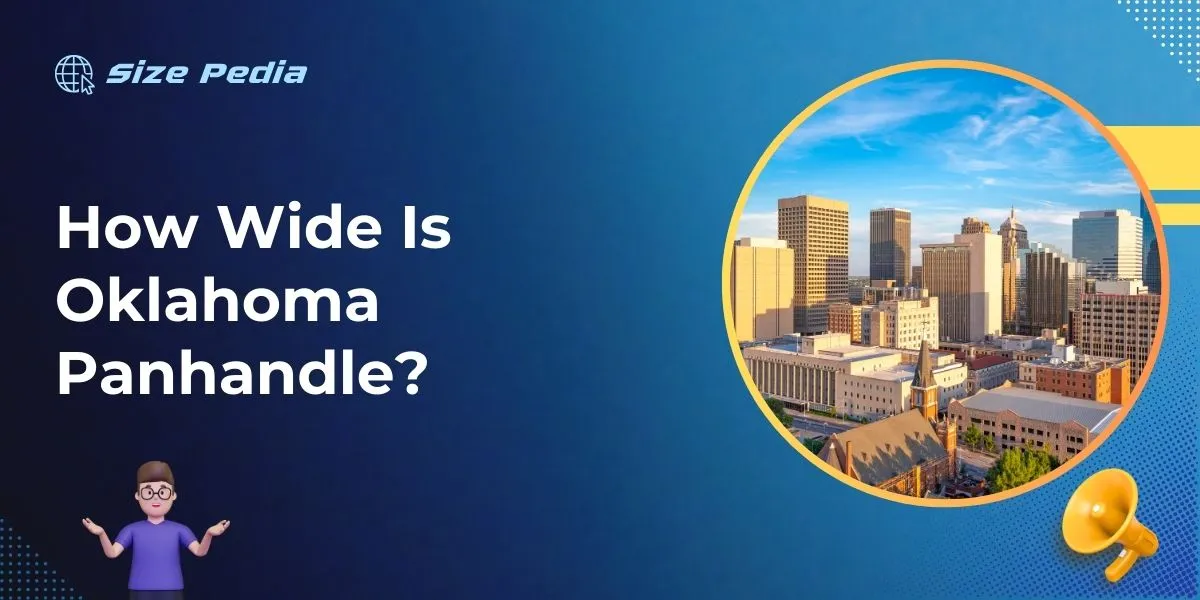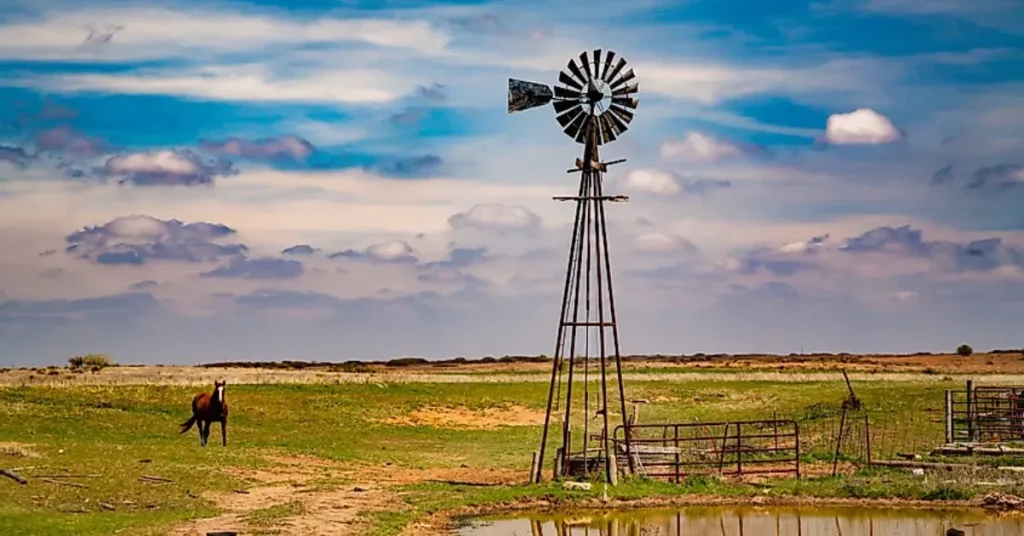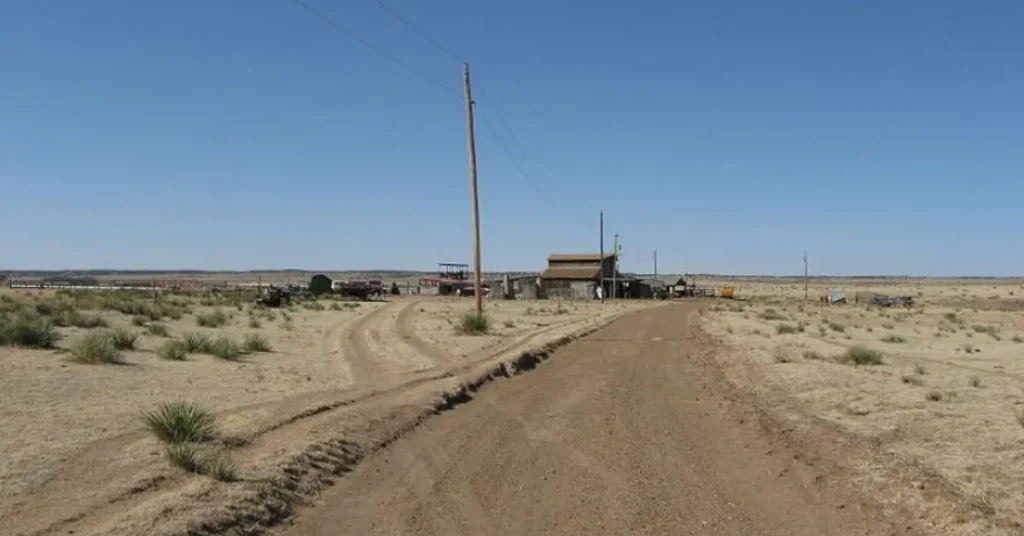The Oklahoma Panhandle is approximately 34 miles wide. It extends over 166 miles in length from the north to the south.
Exploring the distinctive shape of Oklahoma, the Panhandle stands out as a unique geographic feature. This narrow strip of land, bordered by New Mexico, Colorado, Kansas, Texas, and the main body of Oklahoma, has a history and culture all its own.
Known for its flat, expansive plains and agriculture, the Panhandle has become an iconic part of the state’s identity.
Travelers venturing through this region are greeted by the vast openness and the prevailing winds that have shaped the land and its inhabitants’ way of life.
As visitors explore the Panhandle, they find a blend of natural beauty and hardy resilience in both the landscape and the local communities.

Geographic Marvel Of The Oklahoma Panhandle
Imagine touching a real-life tapestry sewn by nature and history. This tapestry is the Oklahoma Panhandle, a geographic marvel stretching across the Great Plains. Here, the land tells stories of the Wild West and whispers of the winds that traverse its flat surface.
Unraveling The Shape Of Oklahoma
The Oklahoma Panhandle is not just a piece of land; it’s a distinctive strip that gives Oklahoma its unique shape. The Panhandle stretches 166 miles long and is 34 miles wide, a thin ribbon of prairie that extends from the main body of Oklahoma.
Visualize the Panhandle as a long hallway connecting rooms in a vast house. Each “room” at its side represents neighboring states: Colorado, Kansas, New Mexico, and Texas.
This area’s shape came from a blend of historical claims and geographical happenings that shaped the state of Oklahoma.
The Significance Of The Panhandle
The Oklahoma Panhandle holds a unique spot in America’s heartland. Wrapped in history and natural beauty, it serves as a bridge between cultures and geographies. Here are some key points highlighting its importance:
- Economic Vitality: Agriculture thrives here, feeding the nation.
- Historical Crossroads: Trails of pioneers pepper the land.
- Natural Wonders: There’s beauty in its open skies and grasslands.
This narrow stretch is more than just land; it’s the lifeblood for communities around it. Its identity is entwined with the heartbeat of Oklahoma, symbolizing resilience and the enduring spirit of the American West.
The Panhandle is not merely an area on the map; it is a testament to the tenacity of the people and the land they call home.
Measuring The Width
The Oklahoma Panhandle, a strip of land that extends westward, is unique in shape. Its width is often a point of curiosity. Let’s delve into the specifics and compare it with other structures.
Statistics And Numbers
Understanding the precise dimensions of the Oklahoma Panhandle provides insight into its geographic significance. This requires examining official statistics.
- The width of the Panhandle is 34 miles (55 kilometers).
- From east to west, it stretches across three counties.
- The exact measurements are critical for cartographic accuracy and regional planning.
Comparison With Other Geographic Structures
Comparing the width of the Oklahoma Panhandle to other geographic features provides perspective.
| Structure | Width |
| Grand Canyon | 18 miles (29 km) at its widest |
| Manhattan | 2.3 miles (3.7 km) wide |
The Panhandle’s width is quite extensive, especially compared to widely recognized landmarks.
Historical Context
The Oklahoma Panhandle stands out with its unique shape. Tracing its borders takes us back through history.
Origins Of The Odd Border
The Panhandle of Oklahoma boasts a distinctive narrow shape. Its dimensions are a result of past legal and political moves. The region stretches 34 miles wide.
In 1850, Texas surrendered its claims to this land. They needed to comply with the Missouri Compromise. The Compromise banned slavery above the 36°30′ parallel.
Left without ownership, the area labeled “No Man’s Land” became a home for settlers. Oklahoma later annexed the strip in 1890, forming its peculiar border.
Impact On State Identity
The Panhandle’s unique form has created a strong identity for Oklahomans. This region holds pride for resilience and frontier spirit.
- Its width gave rise to ranching opportunities.
- It has influenced cultural and economic development.
The Panhandle stands as a symbol of Oklahoma’s diverse tapestry.
Life Within The Panhandle

The Oklahoma Panhandle, a strip of land 34 miles wide, offers a unique experience for its inhabitants. Life here unfolds against a backdrop of wide-open spaces and resilient communities. Let’s dive into the vibrant tapestry that makes the Panhandle a singular place to live.
Demographics And Culture
The Panhandle is home to diverse groups, each contributing to the region’s rich culture. Families pass down traditions and values, shaping the community’s character. A blend of histories and people makes this area distinct.
- Population Density: The area is sparsely populated, fostering tight-knit communities.
- Cultural Mix: Influences include Native American, Hispanic, and Anglo-European heritages.
- Community Events: Local festivities reflect the region’s cultural diversity and historical depth.
Economic Activities And Challenges
Economic life in the Panhandle is dynamic yet faces unique challenges. Agriculture and energy production spearhead economic activities. Community resilience is tested by economic and environmental hurdles.
| Activity | Contribution | Challenges |
| Farming | Mainstay of the economy | Vulnerable to weather patterns |
| Oil and Gas | Significant employment source | Market fluctuations affect job security |
| Renewable Energy | Growth sector | Requires substantial investment |
Stunning Facts About The Panhandle
The Oklahoma Panhandle spans an impressive width that stirs curiosity and awe. Knowing its expanse leads to the discovery of unique features and attractions.
This narrow strip of land, stretching over 166 miles, is home to fascinating climate patterns and one-of-a-kind spots that you won’t find anywhere else in the state.
Climate Anomalies
The Panhandle’s climate is a marvel, showcasing extremes not seen in other regions of Oklahoma.
It undergoes stark temperature changes, from blistering summers to freezing winters. This area is also known for its powerful winds and occasional dust storms, which are rare in the rest of the state.
Year-round, locals and visitors experience:
- Sweltering heat in summer
- Bitter cold in winter
- Swift weather changes
Unique Attractions And Landmarks
Aside from climate, the Panhandle has incredible sites to explore. The Black Mesa area, with its high plateau, offers breathtaking views and hiking adventures.
Not far from there, the landmark known as the Three Corners stands where Oklahoma, New Mexico, and Colorado meet.
Other must-see spots include:
- No Man’s Land Historical Museum – for a dive into local history
- Optima National Wildlife Refuge – a haven for wildlife enthusiasts
- Beaver Dunes Park – with sand dunes that promise fun for every age
| Location | Attraction | Activity |
| Black Mesa | State Park | Hiking & Sightseeing |
| Three Corners | Landmark | Photography |
| Beaver Dunes Park | Recreation | Sandboarding & Camping |
Future Of The Oklahoma Panhandle

An intriguing future awaits the Oklahoma Panhandle, a stretch of land famed for its width and cultural significance.
This region, once a symbol of the rugged American frontier, now stands at the brink of transformation. Anticipation grows as the Panhandle gears up for exciting changes that promise to redefine its horizon.
Development Projects
Major investments target the economic uplift of the Panhandle. With new initiatives underway, residents look forward to enhanced living standards and improved infrastructure. Bold developments are set to propel this region into a vibrant era of growth.
- Renewable Energy Ventures: Wind farms and solar projects harness natural resources to power progress.
- Transportation Infrastructure: Road expansions and improved connectivity pave the way for trade and travel.
- Technology Hubs: Investment in tech start-ups fosters a new wave of local entrepreneurship.
Preservation Efforts
Amidst development, preservation holds a key role. Safeguarding the Panhandle’s unique natural and cultural heritage is a top priority. Initiatives are marked by a dedication to maintain the panoramic beauty and history of this cherished area.
| Preservation Area | Focus Points |
| Environment Conservation | Protecting wildlife habitats and conserving landscapes. |
| Historical Sites | Maintaining landmarks and promoting cultural tours. |
| Agricultural Legacy | Support for sustainable farming and local products. |
FAQs About How Wide Is Oklahoma Panhandle
Why Was Oklahoma Given The Panhandle?
Oklahoma received the Panhandle due to the Compromise of 1850, which redefined Texas borders, leaving this strip unclaimed until Oklahoma’s incorporation in 1890.
What Is The Largest Town In The Oklahoma Panhandle?
The largest town in the Oklahoma Panhandle is Guymon. It serves as the regional hub for business and agriculture.
How Long Does It Take To Drive Across The Oklahoma Panhandle?
Driving across the Oklahoma Panhandle typically takes approximately two to three hours, depending on speed and traffic conditions.
How Wide Is The Texas Panhandle?
The Texas Panhandle has a width of approximately 167 miles (269 kilometers). This region is notably flat and expansive.
Conclusion
Exploring the Oklahoma Panhandle uncovers a breadth of 34 miles, a detail crucial for travelers and geography buffs alike. This slim stretch has a story etched within America’s grand tapestry. Embrace the charm and history found in its modest width.
Discover and visit to experience its unique allure firsthand.
Resources:
1. https://www.weather.gov/ama/panhandle_forecasts
